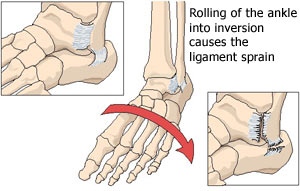Pick a Body Area
Ankle Sprains/Instability

Ankle sprains are a common injury. They usually occur when the foot is forcefully inverted or turned inward. Grade I (minor tear), Grade II (partial tear), or a Grade III (complete tear into two pieces) damage of the outer ligament complex (the anterior talofibular ligament and less often the calcaneofibular ligaments) is the result. Injuries to the inner aspect of the ankle are rare and often result in a fracture before ligamentous damage occurs.
Signs and symptoms of an ankle sprain include lateral ankle pain, swelling and a sense of instability. Stress X-rays may be helpful in ruling out fractures.
Treatment of an acute injury requires rest, ice, compression, elevation, and bracing of the injured ankle. Early rehabilitation assists in a rapid recovery. Surgery (reconstruction of the ligaments) is only necessary when the ankle is repeatedly sprained.
Possible Treatments
- Ankle Active Range of Motion Video
- Ankle Joint Mobilization Video
- Ankle Joint Passive Range of Motion Video
- Ankle Progressive Resistive Range of Motion Video
- Aerobic/Endurance Exercise Video
- Cryotherapy or Cold Therapy Video
- Electrotherapeutic Modalities
- Gait or Walking Training Video
- Isometric Exercise Video
- Plyometrics Video
- Proprioception Exercises Video
- Physical Agents
- Soft Tissue Mobilization Video
- Stretching/Flexibility Exercise Video
- Ankle Active Range of Motion
Possible Treatment Goals
- Improve Balance
- Improve ability to bear weight/stand on the leg(s)
- Decrease Risk of Reoccurrence
- Improve Fitness
- Improve Function
- Optimize Joint Alignment
- Improve Muscle Strength and Power
- Increase Oxygen to Tissues
- Improve Proprioception
- Improve Range of Motion
- Self-care of Symptoms
- Improve Safety
- Improve Tolerance for Prolonged Activities
Additional Resources
Disclaimer
The information in this medical library is intended for informational and educational purposes only and in no way should be taken to be the provision or practice of physical therapy, medical, or professional healthcare advice or services. The information should not be considered complete or exhaustive and should not be used for diagnostic or treatment purposes without first consulting with your physical therapist, occupational therapist, physician or other healthcare provider. The owners of this website accept no responsibility for the misuse of information contained within this website.
